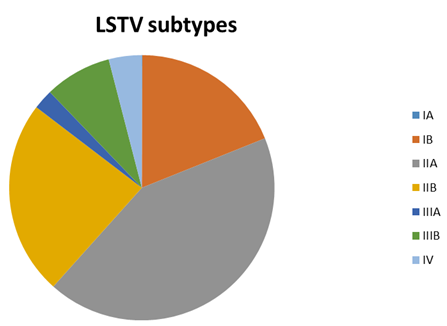Lumbosacral transitional vertebra: Prevalence and association with low backache
Abstract
Study Design-Retrospective observational analysis of radiological images.
Purpose- To determine the prevalence of lumbosacral transitional vertebra (LSTV) in patients symptomatic with low backache and study the association of type of LSTV with low backache.
Materials & Methods: Standard standing lumbosacral spine AP radiographs were obtained for 6000 patients aged between 18-60 years of age. The lumbosacral spine was assessed for the presence of lumbosacral transitional vertebra which was further classified into type I, II, III, IV based on Castellvi’s method. The association of low backache (LBA) with the subtypes of LSTV was also studied.
Results: The prevalence of lumbosacral transitional vertebra was found in 6.45 % (387 out of 6000), of which type II (pseudo articulation, unilateral or bilateral) was the commonest type found in 62.7 %, followed by type I (dysplastic transverse process) in 23.2 %, type III (true fusion) in 10.1 % and type IV (mixed, unilateral pseudo articulation and contralateral true fusion) in 3.8 %. The subtype IIA was found strongly associated with low backache.
Conclusions: In this cohort-based study, the prevalence of LSTV was studied and a positive association of LSTV was established to be considered as one of the differentials of low backache.
Downloads
References
Castellvi A, Goldstein L, ChanD. Lumbosacral transitional vertebrae and their relationship with lumbar extradural defects. Spine 1984;9:493-5.
Konin GP, Walz DM. Lumbosacral transitional vertebrae: classification, imaging findings, and clinical relevance. AJNR Am J Neuroradiol 2010;31:1778-86.
Bron JL, van Royen BJ, Wuisman PI. The clinical significance of lumbosacral transitional anomalies. Acta Orthop Belg 2007;73:687-95.
Bertolotti M. Contributo alla conoscenza dei vizi di differenzazione regionale del rachide con special riguardo all’ assimilazione sacrale dellav. lombare. Radiol Med 1917;4:113-144.
Daniel P, Joel JJ, Rana PK. Lumbosacral transitional vertebrae in patients with low back pain: Radiological classification and morphometric analysis. J Anat Soc India 2019;68:123-8.
Gopalan B, Yerramshetty JS. Lumbosacral transitional vertebra–related low back pain: Resolving the controversy. Asian Spine J 2018;12:407-15.
Ucar BY, Ucar DE, Bulut M, Azboy I, Demirtas A. Lumbosacral transitional vertebrae in low back pain population. J Spine 2012;2:125.
Oyinloye OI, Abdulkadir AY, Babalola OM. Incidence and patterns of Lumbosacral transitional vertebrae, in patients with low back pain in a Nigerian hospital. Nig Q J Hosp Med 2009;19(2):95-99.
Quinlan JF, Duke D, Eustace S. Bertolotti’s syndrome. A cause of back pain in young people. J Bone Joint Surg Br 2006;88:1183-6.
Hughes RJ, Saifuddin A. Imaging of lumbosacral transitional vertebrae. Clin Radiol 2004;59:984-91.
Delport EG, Cucuzzella TR, Kim N, Marley J, Pruitt C, Delport AG. Lumbosacral transitional vertebrae: Incidence in a consecutive patient series. Pain Physician 2006;9:53‑6.
Peterson CK, Bolton J, Hsu W, Wood A. A cross-sectional study comparing pain and disability levels in patients with low back pain with and without transitional lumbosacral vertebrae. J Manipulative Physiol Ther 2005;28(8):570–574.
Taskaynatan MA, Izci Y, Ozgul A, Hazneci B, Dursun H, Kalyon TA. Clinical significance of congenital lumbosacral malformations in the young male population with prolonged low back pain. Spine (Phila Pa 1976) 2005;30(8): E210–E213.
Luoma K, Vehmas T, Raininko R, Luukkonen R, Riihimäki H. Lumbosacral transitional vertebra: relation to disc degeneration and low back pain. Spine (Phila Pa 1976) 2004;29(2):200–205.
Steinberg EL, Luger E, Arbel R, Menachem A, Dekel S. A comparative roentgenographic analysis of the lumbar spine in male army recruits with and without lower back pain. Clin Radiol 2003; 58(12):985–989.
Kim NH, Suk KS. The role of transitional vertebrae in spondylolysis and spondylolytic spondylolisthesis. Bull Hosp Jt Dis 1997;56:161‑6.
Chithriki M, Jaibaji M, Steele RD. The anatomical relationship of the aortic bifurcation to the lumbar vertebrae: an MRI study. Surg Radiol Anat 2002;24(5):308–312.
Otani K, Konno S, Kikuchi S. Lumbosacral transitional vertebrae and nerve-root symptoms. J Bone Joint Surg Br 2001;83:1137-40.
Erken E, Ozer HT, Gulek B, Durgun B. The association between cervical rib and sacralization. Spine 2002;27:1659-64.
Santiago FR, Milena GL, Herrera RO, Romero PA, Plazas PG. Morphometry of the lower lumbar vertebrae in patients with and without low back pain. Eur Spine J 2001;10:228–33.
Hsieh CY, Vanderford JD, Moreau SR, Prong T. Lumbosacral transitional segments: classification, prevalence, and effect on disk height. J Manipulative Physiol Ther 2000: 23: 483-89.
Stinchfield FE, Sinton WA. Clinical significance of the transitional lumbosacral vertebra; relationship to back pain, disk disease, and sciatica. J Am Med Assoc 1955;157:1107‑9.
Tini PG, Wieser C, Zinn WM. The transitional vertebra of the lumbosacral spine: Its radiological classification, incidence, prevalence, and clinical significance. Rheumatol Rehabil 1977;16:180‑5.
Ahmadinejad N, Ghanaati H, Firouznia K, Khaghani A, Salavati A, Shakiba M. Pathological findings of spinal MRI in patients with the lumbosacral transitional vertebra. Res J Biol Sci 2009;4:166‑70.
Eyo MU, Olofin A, Noronha C, Okanlawon A. Incidence of lumbosacral transitional vertebrae in low back pain patients. West Afr J Radiol 2001;8:1‑6.
Dai L. Lumbosacral transitional vertebrae and low back pain. Bull Hosp Jt Dis 1999;58:191‑3.



























